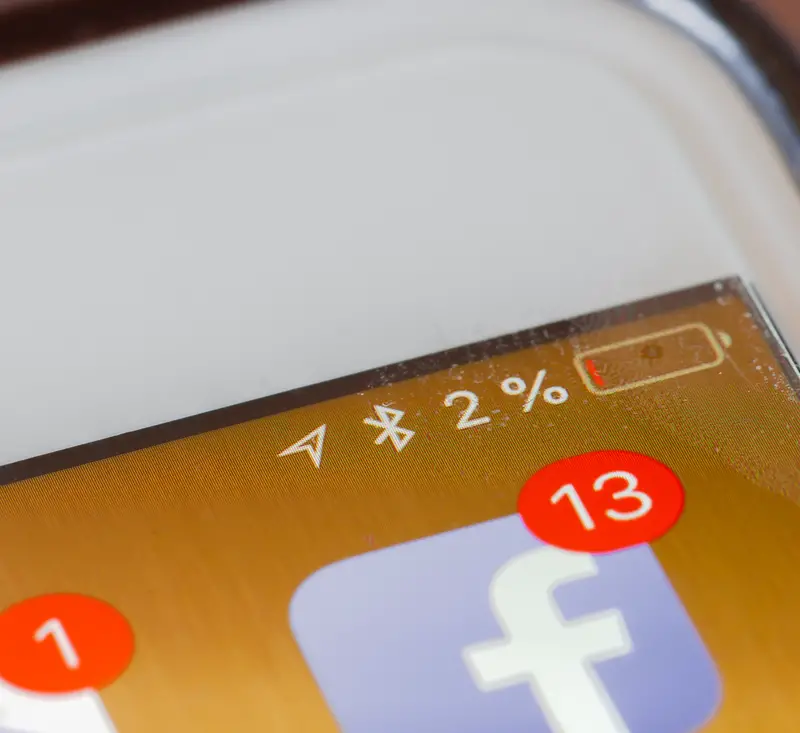Most people think charging their phone to 100% is the best thing they can do for their battery. That glowing green icon feels like victory, right? Wrong. Letting your phone battery hit certain percentages is actually destroying it from the inside out. The worst part? Once the damage starts, there’s no going back. Your phone will start dying faster, getting hotter, and eventually becoming that frustrating device that dies at 30% battery life.
Zero percent will permanently damage your battery
When your phone dies completely, something terrible happens inside the battery that most people never realize. The lithium inside your battery gets permanently stuck in place, unable to return to its normal state. Think of it like a traffic jam that never clears – those lithium particles are blocked forever. Every time you let your phone hit zero percent, you’re losing a chunk of your battery’s ability to hold a charge.
The longer your phone stays dead, the worse the damage gets. Some lithium stays permanently bonded and can’t participate in powering your phone anymore. This is why phones that frequently die completely start showing that dreaded “battery health” decline so quickly. If your phone drops below 20%, turn it off immediately and find a charger.
One hundred percent charging creates heat damage
That satisfying 100% charge is actually your battery’s worst nightmare. When your phone reaches full charge, the lithium molecules start resisting the electrical process, creating excess heat and stress. It’s like forcing someone to eat when they’re already completely full – nothing good comes from it. The battery components expand from the heat, then contract when cooling down, creating microscopic cracks over time.
These tiny cracks in the anode make it harder for electricity to flow properly, forcing your phone to work harder just to charge and discharge. The combination of full charge and warmth causes more stress to your battery than actually using it does. Modern phones try to help with optimized charging features, but the damage still accumulates if you consistently charge to 100%.
The sweet spot is between twenty and eighty percent
Battery experts have discovered that lithium-ion batteries live their happiest lives in the middle range. When you keep your phone between 20% and 80%, the lithium can move back and forth easily without getting stressed or damaged. It’s like keeping your car in the middle lanes of traffic instead of constantly swerving between the shoulder and the fast lane.
Electric vehicles actually use this principle by design – their massive batteries are programmed to never truly reach 0% or 100% even when the display shows those numbers. This mid-range use delivers far more charging cycles than the full charge-discharge pattern most people use with their phones. Start unplugging your phone around 80% and plugging it in around 30-40%.
Fast charging while hot multiplies the damage
Summer car dashboards and fast chargers create the perfect storm for battery destruction. When your phone gets hot from the sun or intensive apps while simultaneously fast charging, the internal components face extreme stress. The rapid electricity flow generates heat, and external heat sources make everything worse. Your battery’s anode expands and contracts rapidly, creating permanent damage.
The worst scenario happens when someone leaves their phone charging in a hot car or uses intensive apps while fast charging. Heat damage to the anode creates irreversible cracks that make future charging less efficient. Your phone will start taking longer to charge and dying faster, even when the battery percentage looks healthy.
Multiple small charges beat one full cycle
Forget everything you learned about old batteries needing full discharge cycles. Modern lithium-ion batteries prefer frequent small top-ups over complete charge cycles. Plugging in for 10-15 minutes here and there throughout the day is actually better for battery health than letting it drain to 20% and charging back to 100%. It’s like eating small healthy meals instead of starving then binge eating.
This approach keeps your battery in that happy middle zone more often. Short charging spurts prevent the stress that comes from extreme high and low percentages. Keep a charger at your desk, in your car, and anywhere you spend time regularly. Your battery will thank you with years of reliable performance.
Background apps drain damaged batteries faster
Once your battery starts showing damage from poor charging habits, background apps become the enemy. Apps checking GPS, refreshing social media, and maintaining connections all draw power continuously. A healthy battery can handle dozens of background processes, but a damaged battery struggles with even basic tasks. The result is rapid battery drain that seems to come out of nowhere.
Social media apps, navigation programs, and streaming services are particularly power-hungry when running in the background. Processing data and maintaining signals constantly tax your battery’s remaining capacity. Check your phone’s battery usage settings to identify which apps consume the most power and consider closing them when not needed.
Screen brightness compounds battery problems
Maximum screen brightness doesn’t just drain your battery – it creates heat that damages it further. Modern phone screens can get incredibly bright, especially OLED displays that make every pixel glow individually. When you combine high brightness with other power-intensive tasks, your phone becomes a tiny heater that slowly cooks its own battery from the inside.
Automatic brightness adjustment often makes things worse on sunny days when your phone is already warm from external heat. The screen covers one whole side of your phone, spreading heat throughout the device. Turn off auto-brightness and manually adjust it to the lowest comfortable level, especially when your battery is already showing signs of degradation.
Optimized charging helps but isn’t perfect
Most modern phones include optimized charging features that slow down the final charging phase, but these systems aren’t foolproof. iPhones and Android devices try to learn your routine and delay reaching 100% until you actually need the phone. However, these features only work when your phone can predict your schedule, and they don’t address the fundamental problem of charging to 100% regularly.
The AI systems managing optimized charging sometimes guess wrong about your schedule, leaving you with a phone that didn’t charge overnight when you needed it most. These features delay charging past 80% only when they predict extended connection to power. Manual habits still matter more than automated systems for long-term battery health.
Wireless charging adds heat but offers convenience
Wireless charging pads generate more heat than wired charging, but they can actually help your battery health if used correctly. The convenience factor helps people maintain better charging habits by making it easy to top off frequently throughout the day. However, leaving your phone on a wireless charger overnight while it reaches and maintains 100% creates prolonged heat exposure.
The key is using wireless charging for short sessions rather than extended periods. Recent studies suggest batteries like warmth during the actual charging process but should stay cool when storing power. Use wireless charging for quick top-ups at your desk or nightstand, but remove the phone once it reaches your target percentage.
Understanding these battery-damaging percentages can add years to your phone’s life and save hundreds of dollars in early replacements. The 0% and 100% zones are danger areas that create permanent damage every time you visit them. Stick to the 20-80% range, charge frequently in small amounts, and keep your phone cool whenever possible. Your future self will thank you when your phone still holds a decent charge after two years instead of dying at 30% like so many other devices.

